Horses come in many beautiful colors. The most common horse colors in the world are bay and chestnut, followed by grey and black.
There are other colors that are variations of these that are still considered common, but just not as much. But did you know that there are other colors—unusual and rare horse colors that you have never seen—and coat patterns that you have never heard of a horse having before?
These horses are so rare, but they do exist. To own one would be lucky, to say the least. But even to see one in person would be a privilege. Most people will not get the chance to see a horse with one of these special coat colors in person.
In this article, I will be going over 20 different rare horse coat colors and patterns. I will share a photo for each color. For the colors or patterns without a photo, I will share a link to a photo so you can really see what they look like. (I just can’t post the photos in this article if I don’t have rights to use them due to copyright reasons.)
So without further adieu, let’s take a look at the different coat colors and patterns horses can have that are not seen very often or talked about.
Let me know in the comments which one is your favorite!
1. True Black
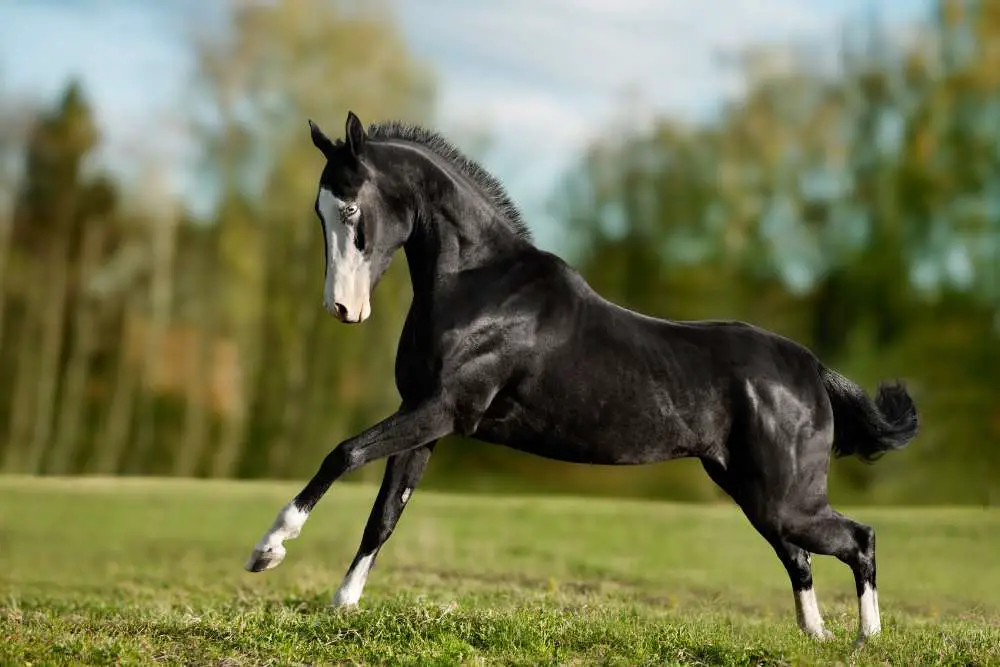
True black horses have dark brown eyes, black skin, and black coats. They have no red or brown shading anywhere on the body. True black is sometimes confused with homozygous black, which are horses that cannot produce offspring with the red gene. That means they can never have chestnut foals, only bay and black. Breeds like the Friesian are true black, with the majority of Friesians being pitch black with dark skin and dark eyes. You will never find a true Friesian who is chestnut.
2. Silver Dapple
Silver dapple, also known as the “silver gene,” is rare and doesn’t occur at all in certain breeds. Breeds that more commonly have the silver gene include the Gypsy Vanner and the Rocky Mountain Horse.
It can be present with any of the three base coats: black, chestnut, or bay. However, on a chestnut, there is no effect on the horse’s coat.
Some of these horses have noticeable grayish-silver dapples against their dark coats, and some of them have more solid-looking coats where it is harder to see the dapples. The solid coats are often referred to as “chocolate” because the color looks similar to that of chocolate.
However, when you clip the coat of a silver dapple, the short clipped hair of the undercoat is brilliant. It looks like a dapple grey horse, but with uniform dapples and a silver-colored coat, hence the name silver dapple.
Black Silver
Black base horses with the silver gene are called Black Silver.
Bay Silver
A bay with the silver gene is called Bay Silver.
3. Silver Buckskin
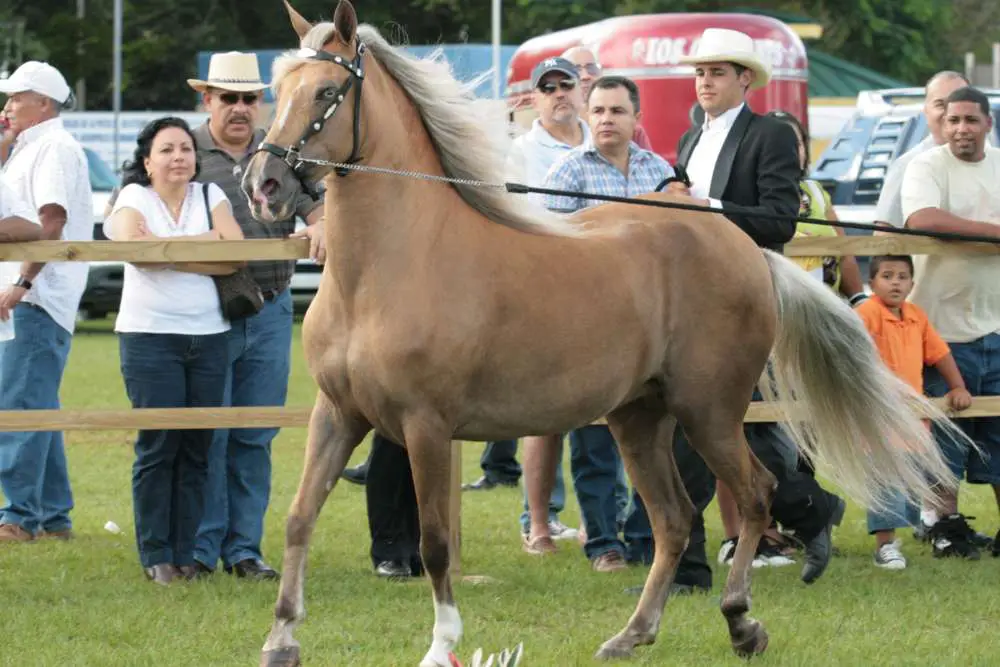
If you think a silver bay or silver black is a rare color, a silver buckskin is even more so.
A silver buckskin is a horse that has a bay base coat with both the cream gene and the silver gene.
You may see the term “silver buckskin” being used for buckskin horses with a pale coat color known as “buttermilk” or buckskins that are turning grey or roaning. Those are not true silver buckskin horses.
If you wanted to breed yourself a silver buckskin horse, you would need to find a buckskin (which has a bay base) and cross that onto a horse that carries the silver gene.
Even then, the percentage chance of the foal inheriting both the cream buckskin gene from one parent and the silver gene from the other is not high.
4. Silver Dapple Pinto
A silver dapple pinto is about as rare as a silver buckskin. To understand a silver dapple pinto horse, we have to first look at two separate colors: pinto and silver dapple. The silver dapple gene can only be present on black or bay coats. For black horses, that means it can affect their whole body, and for bay horses, it can affect their main and tail, and the silver dapples are in their undercoat, which is visible with clipping.
A horse that is silver dapple often has a chocolatey-colored coat with a silver mane and tail. Horses with a red coat can have the silver dapple gene, but you won’t be able to see any difference in their coat visually.
A pinto horse coat pattern is a type of coat color pattern characterized by large patches of white and other colors such as black, bay, chestnut, dun, grullo, or silver. Pinto horses can have any of these colors, as well as any combination of them. The white and colored patches may be randomly distributed or in specific patterns, such as a blanket, tobiano, frame, or sabino.
That means to get a silver dapple pinto horse, the horse needs to have a base color of silver dapple with the dominant pinto gene.
5. Champagne
Champagne coat colors come in four different types: gold champagne, amber champagne, classic champagne, and sable champagne.
The champagne “gene” acts on one of four base colors to create one of the four coat types listed above. Classic champagne is the most popular when it comes to champagne colors. Gold champagne horses are often mistaken for palominos due to having a similar coat color.
Champagne Gold
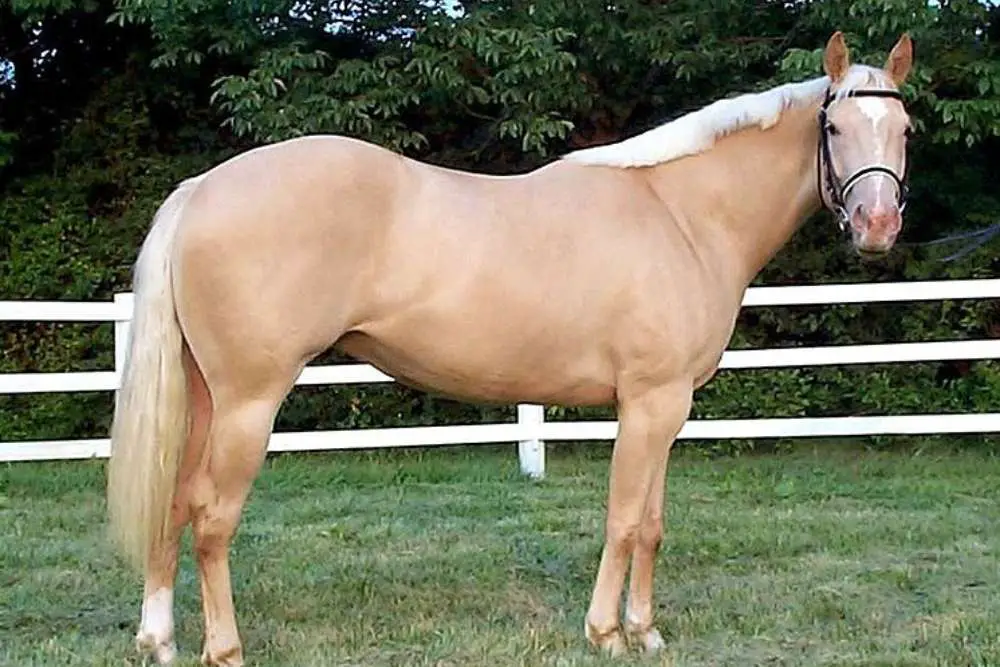
Gold champagne is made by adding the champagne modifier to a red (or chestnut/sorrel) base.
Classic Champagne
Black is the base color for a classic. The skin is also grey, but it can sometimes look like it has a pink or purple tint to it.
Amber Champagne
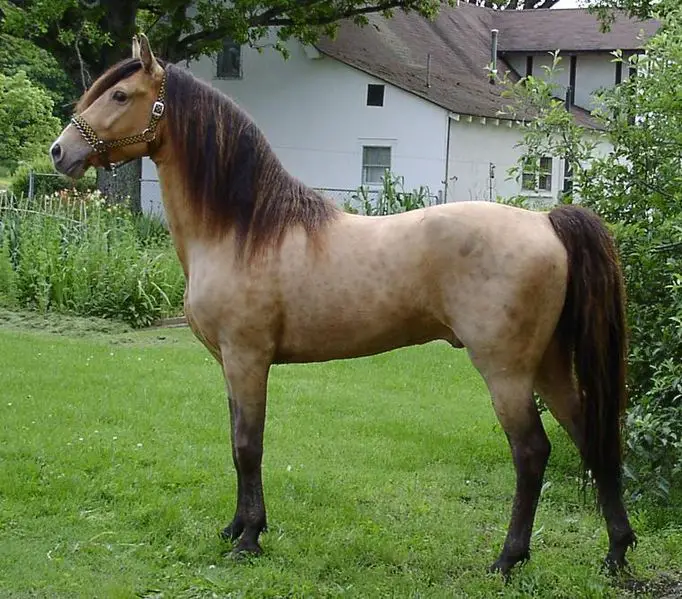
This is the outcome of a champagne gene present in a bay horse. There are three different colors of amber champagne: classic amber, cream, and ivory.
Sable Champagne
A seal bay or seal brown with the champagne gene present is a sable champagne. Because black bays and seal bays look so much alike, it could also be caused by a black bay with the champagne gene.
6. White
Dominant White
Dominant white horses are genetically different from the more common gray. Grey horses are born with a darker base color (like bay, chestnut, or black), which then fades as the horse gets older. Dominant white horses are born with pink skin and white hair, but they do have dark eyes (unlike a cremello horse that comes from two cream genes on a chestnut base that can appear white but has blue eyes). Generally, one parent needs to be dominant white to produce a dominant white foal. But there have been cases of spontaneous mutations where a foal with no dominant white parents was born completely white.
Maximum White Sabino
This color pattern is characterized by an entire body covered in mostly white hairs, or even completely white hairs. To be considered a true Maximum Sabino, the white must cover over 50% of the horse’s body.
This stunning coat color is one of the rarest to occur in horses and can be found in a variety of breeds. Maximum Sabino horses are born with a variety of white markings, ranging from four white stockings to a completely white face. As they age, they tend to grey out or roan into a solid white, which highlights the beauty of this unique coat color.
Lethal White Foal Syndrome
Lethal White Foal Syndrome (LWFS), also known as Lethal White Overo Syndrome, is an unfortunate genetic defect that can occur when two heterozygous frame overo horses are bred together. LWFS is characterized by a foal born with pink skin and white hair covering the body, blue eyes, and internal issues such as colon failure. Unfortunately, LWFS is fatal, and the foal usually either is stillborn or dies within a couple of days after birth.
The best thing to do for a foal with LWFS is to put it down to prevent the foal from being in any pain before eventually dying. It is important to note that lethal white is as close to an albino as you’ll see in the equine world. This is because albinism doesn’t even exist in horses because it’s fatal. If it does happen, the foal dies in utero.
The best way to prevent LWFS is to only breed frame overo horses with non-frame overo horses. This ensures that the gene combinations will not result in a lethal white foal. Additionally, it is important to be aware of the genetic history of the horses you plan to breed. This can help identify any potential for LWFS and reduce the likelihood of it occurring.
7. Perlino
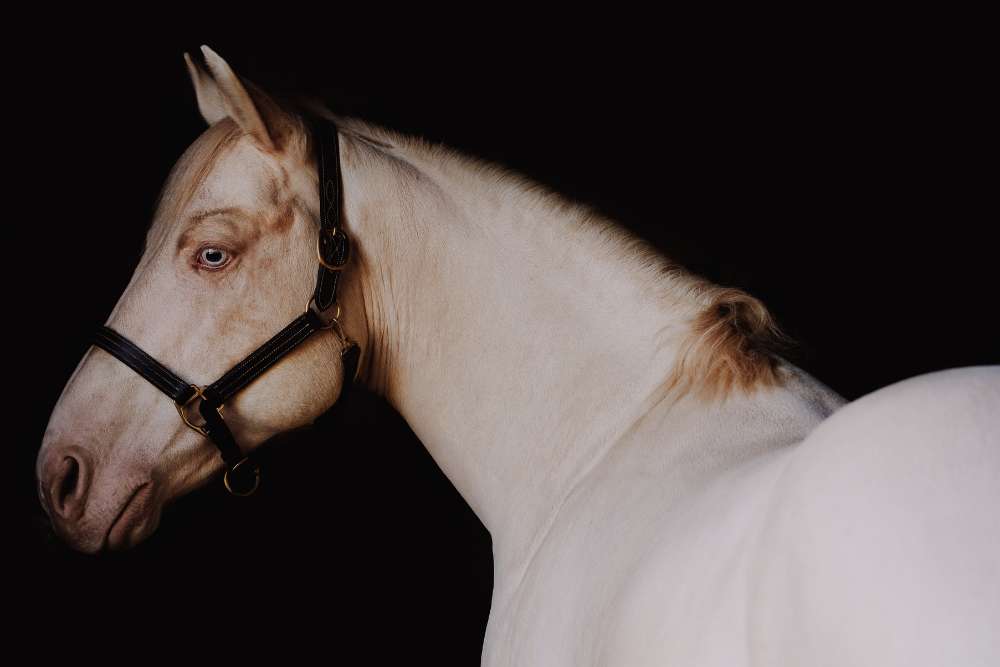
Perlino horses have creamy colored coats with pink skin and blue eyes. Their color can range from a super pale brown to an off white. Their manes and tails often have a slight coffee color to them, which can help distinguish them from a cremello. Perlinos have a bay base color but are homozygous for the cream dilution gene. To simplify, that means a perlino will always produce dilute babies (palomino, buckskin, or smoky black, for example).
8. Pearl
Pearl shares the same sort of look as other dilutes like champagne and cremello, but it is more rare and typically found in just a few breeds like American Quarter Horses, Paints, and Iberian Horses such as the Andalusian and Lusitano or ones descended from Iberians. It is caused by a recessive gene, meaning that two copies of the gene are required to produce the color. The end result is a horse with a coat that is light and creamy, often with a hint of pink or apricot color.
9. Mushroom
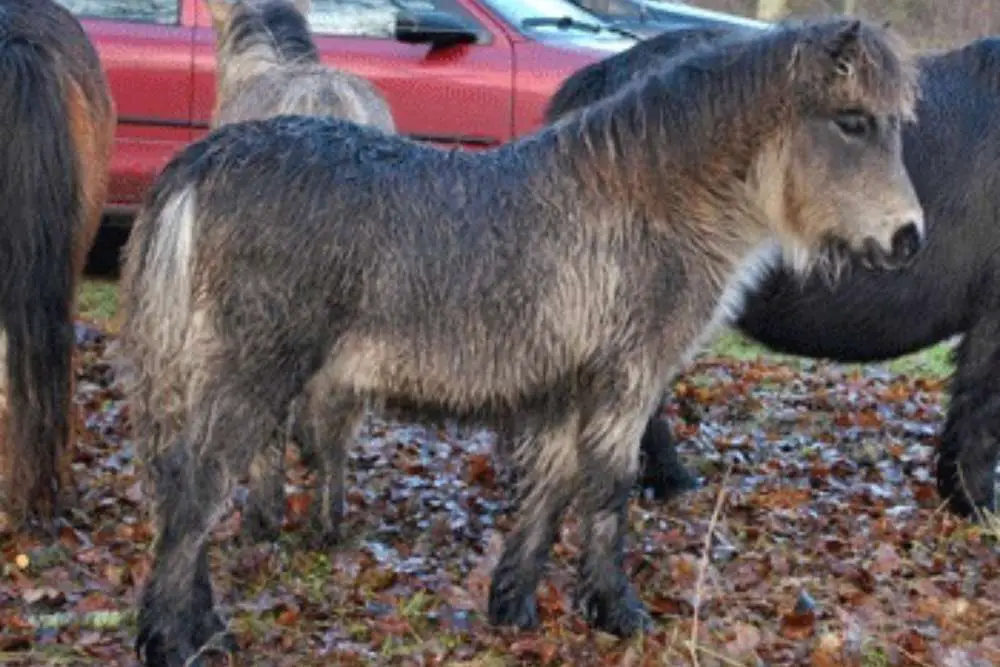
Yes, you read that right. There is such a thing as a mushroom horse! Or rather, a mushroom pont. Mushroom is a diluted coat exclusively found in Shetland ponies. These ponies have a sepia-colored coat with a flaxen (light) mane and tail. This mushroom dilution has not been found in breeds other than the Shetland pony.
10. Smoky Cream
Smoky cream horses genetically have a black base coat but are homozygous for the cream dilution gene. If you’ve read about perlinos, you will understand what that means! Smoky cream horses are not as common as perlino horses. They have creamy-colored coats with pink skin and blue eyes, like other cream horses. They are sometimes confused with Perlino because they too can share a coffee-colored hue.
11. Rabicano
Rabicano is a term that describes white flecks on a horse’s body that appear in a specific pattern. It is this pattern that distinguishes a horse that is rabicano compared to a horse that is roan (roan horses have white flecks over their entire body, except for the head and legs). A red rabicano is a horse with a red (or chestnut/sorrel) base and the rabicano gene. Red rabicano horses often have heavy white flecks on their flanks (the back part of a horse’s abdomen) that then spread out from there, decreasing in frequency as the color spreads out. You can also find bay and black rabicano horses.
12. Metallic Sheen
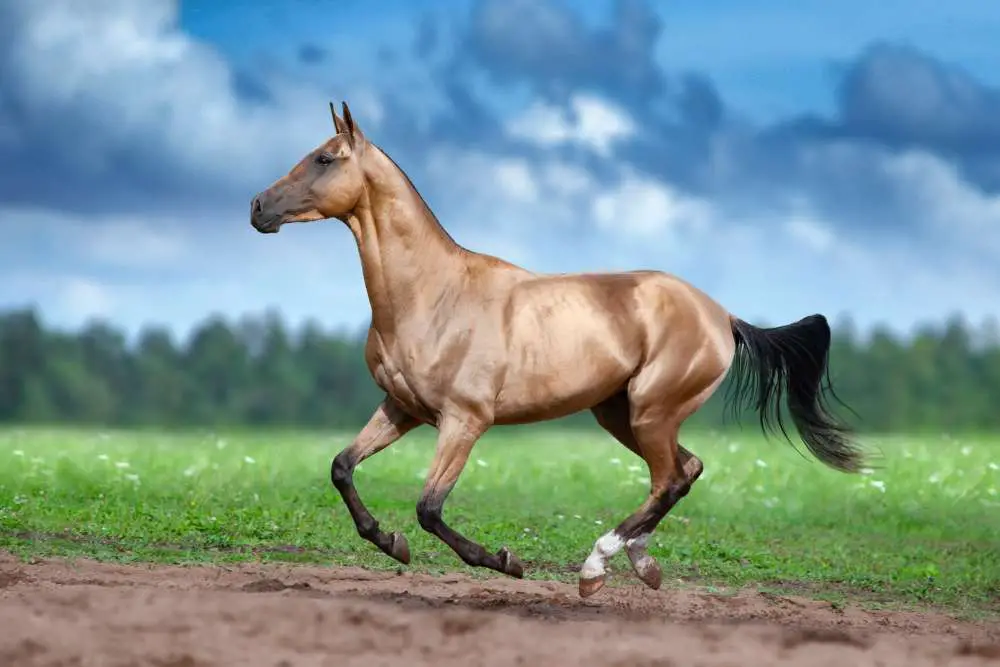
Metallic sheen is not so much a color as an appearance. There is one breed that is particularly famous for their metallic sheen, and that is the Akhal-Teke. There are no other breeds that shine quite like these horses, but Akhal-Tekes are a rare breed with a small population. But what gives this breed their rare metallic coats, and are they really shinier than other horses?
Akhal-Tekes have a unique coat structure with fine hairs that lack the opaque core of a normal horse’s hair shaft. This means that the individual hairs are able to pass light through the hair and refract it onto the other side. Basically, that means they really are that shiny!
13. Sooty
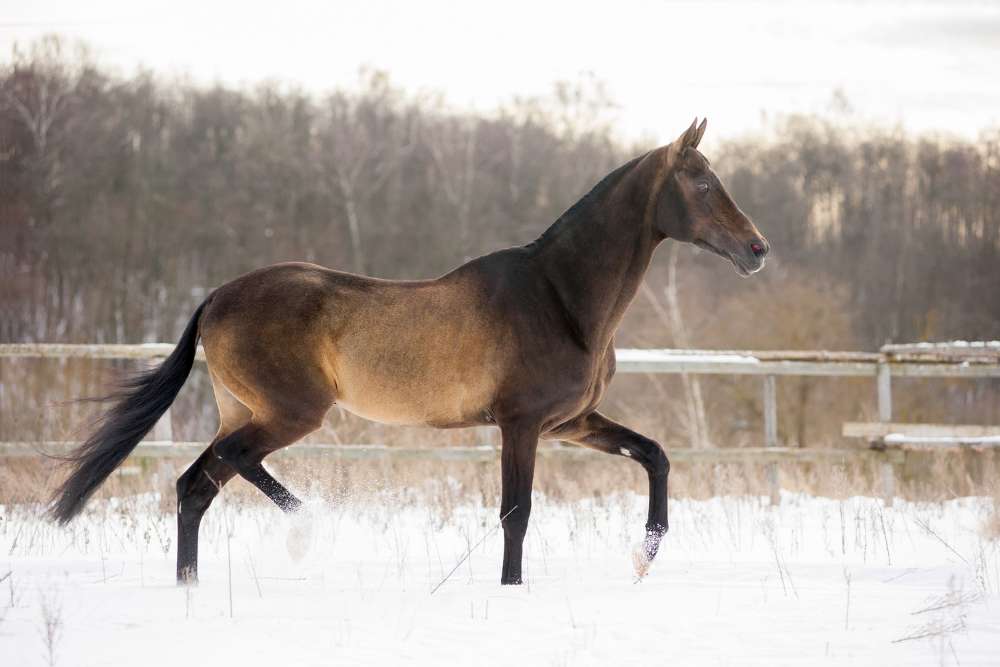
Sooty is a rare coat color modifier in horses that is sometimes also referred to as “smutty.” It is most commonly seen in bays, buckskins, and palominos and causes the coat to appear darker in coloration.
Sooty horses are fairly easy to distinguish from other colors by looking at the dark or black hairs that are mixed in with a lighter coat color.
These dark hairs are typically heavier along the top of the horse and become less frequent on the lower parts of the body. It is sometimes concentrated in the mane and tail, while other times it can cover the entire body.
Scientists presume sootiness is inherited from the horse’s parents, but the exact way this works is not well understood.
This gene was once believed to be responsible for turning chestnuts into liver chestnut horses, but that is no longer a shared belief.
14. Leopard Spotting
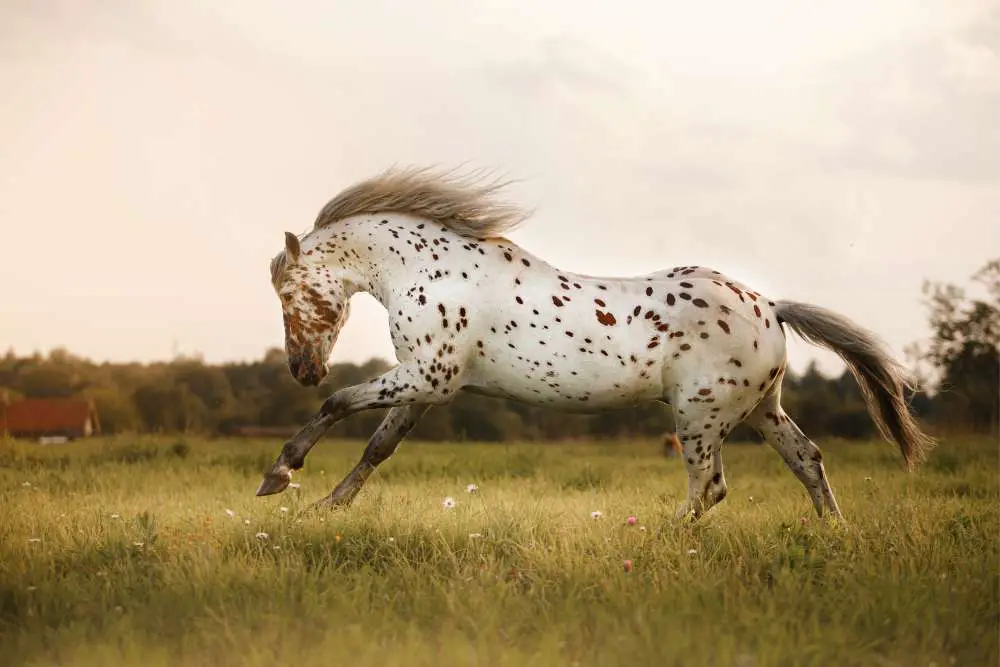
Leopard spotting (also known as leopard complex) is a coat pattern mainly found in the appaloosa and Knabstrupper breeds. The coat colors and appearances of horses with leopard spotting can vary widely, with some having heavy white hairs (sometimes appearing to be roans) and others having a Dalmatian-like appearance with large dark spots on a white base coat. The leopard complex gene is beautiful, but it also comes with certain risks. Horses that carry it have an increased risk of eye and vision abnormalities.
15. Peacock Appaloosa
This is an unusual pattern that only appears on Appaloosa horses. It is caused by a unique set of gene expressions that don’t occur very often. The peacock pattern features a white base coat with leopard-like spots that are organized in a target-like pattern, comparable to the leopard spotting mentioned above.
The spots on a Peacock Appaloosa are usually bigger than those on a regular Appaloosa, and they are usually arranged in a symmetrical pattern with a larger spot in the middle and four to six smaller spots evenly spaced around it. Spots can be any color, but black, bay, chestnut, and grey are the most common. There may also be different shades of color in the spots, which makes for a unique and eye-catching pattern.
16. Snowflake Pattern
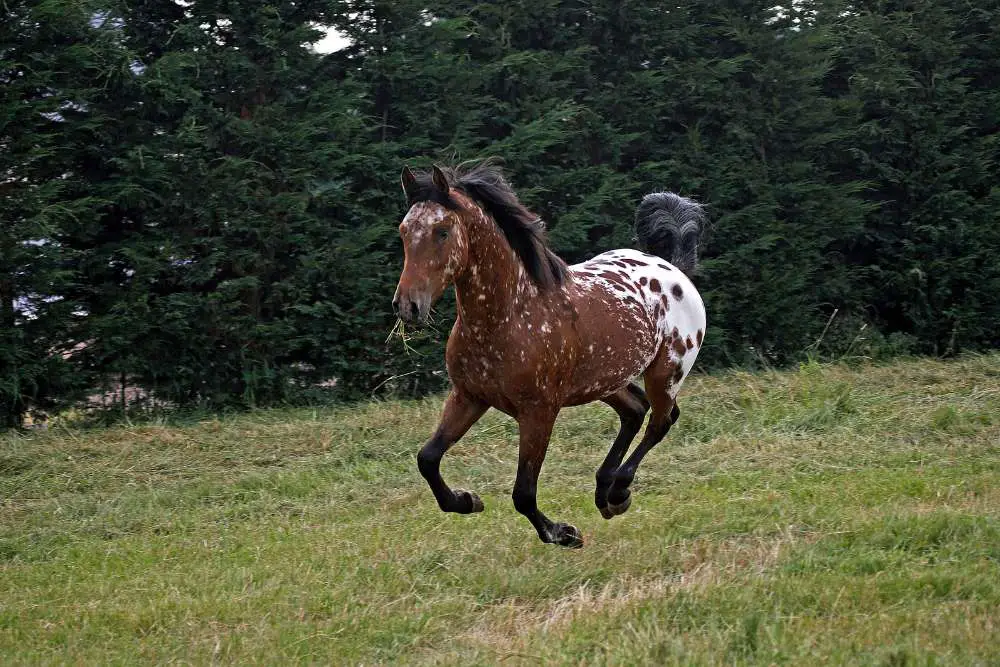
Think of snow falling on the horse; that is what the horse looks like, well, almost.
The snowflake pattern is pretty much the opposite of the leopard spotting you normally see in a leopard appaloosa. Instead of the spots being black on a white body, with the snowflake pattern it is white spots on a solid colored body, with the white being all different sizes.
You can be confused between a snowflake and a blanket appaloosa at first, but the key distinction is the size and location of the spots. With the snowflake pattern, the spots will be smaller and more evenly spread across the horse’s body. A blanket appaloosa, on the other hand, will have big and small spots mostly on its rump. Also, it helps to know that the spots are usually round or oval and no bigger than the width of your hand.
The snowflake pattern is created by a single gene that is found in some breeds of horses, typically the appaloosa. It is a dominant gene, meaning that if a horse has one parent with the gene, they will most likely inherit it as well.
The snowflake is also considered a rare pattern, and it is uncommon to see a horse with this kind of coat.
17. Birdcatcher Spots
These small, spontaneous white spots go by many different names but are most commonly referred to as “birdcatcher spots.” You may have noticed that old injuries on your horse will heal over with white hairs, but these white spots are not due to injury or skin damage.
These spots tend to run in families (a mare with birdcatcher spots often has parentage that has them too).
Where did the name “birdcatcher” come from?
There was once a thoroughbred racehorse who featured these white spots. His name was Birdcatcher, and he was born in 1833. He passed his signature spots onto many of his offspring.
Do you have a thoroughbred with these white dots?
Try having a look as far back in their pedigree as you can; maybe they are a distant relative of the late Birdcatcher!
18. Chubari
Chubari spots are a unique pattern found only on grey horses. These spots are distinct from dapples, and are easily recognized by their round and egg-like shape with well-defined edges.
They often appear on the sides, neck, and back of a grey horse and are sometimes referred to as “coin spots.” The spots are most evident when the horse is still a medium to dark grey, and can also be seen on the flanks and even on the legs as well.
As the horse’s coat begins to turn white, the Chubari spots will start to blend in with the rest of the horse’s hair and can become invisible over time. Depending on the horse’s age and the degree of white coloring, the Chubari spots may become more or less visible.
19. Bend-Or Spots
Bend-or spots are these dark, random spots that can sometimes be found covering a horse’s body. They are also known as “smut” or “grease spots” and can range in color from dark red to black.
These spots got their name after the infamous horse, Bend-or, who was born in 1877. He was a chestnut thoroughbred stallion who had a distinctive white blaze on his forehead and dark random spots covering his body. Bend-or was a successful racehorse and sire, and his unique coat pattern of white and black spots inspired the name of these spots—Bend-or spots.
Bend-or spots are not caused by any disease or inherited genetic traits; instead, they are caused by a number of factors that can affect a horse’s coat color. These include hypopigmentation, which is the loss of normal pigmentation in the skin; post-inflammatory hypopigmentation, which is from an injury or infection; and genetic factors, which can affect the amount of pigment in the skin.
Bend-or spots can vary in size and shape, from small and round to large and irregular. They can be found on any area of a horse’s body, but it’s most common to find them on the horse’s legs, chest, neck, and forehead.
20. Vitiligo
Vitiligo is a fairly rare auto-immune condition. It is believed to be due to nutritional deficiencies in the horse. Vitiligo is a pattern of pigment loss across the horse’s body, and it can actually look quite unique.
The most common areas of pigment loss are the eyes, nose, and genitalia, although sometimes the whole body can become affected. One of the best things about vitiligo is that it has no impact on the horse’s health or performance. It is purely a visual condition and has no effect on the horse’s fitness or ability to engage in activities.
You can manage this condition fairly easily by feeding the horse an appropriate diet and supplements. In addition, there are other therapies, such as light therapy. It is possible to minimize the pigment loss that comes with vitiligo and enhance the horse’s coat color with the proper mix of treatments. But if you choose to forgo the treatments, it will not hurt the horse.
In spite of the auto-immune illness, the pattern that the loss of pigmentation creates is often eye-catching and unique.
21. Brindle And Reverse Brindle
Brindle horses are exceptionally rare but are very easy to spot.
The brindle color has a distinctive pattern of vertical stripes that sometimes resembles that looks similar to tiger stripes or brindle dogs
However the brindle pattern is not a gene and cannot be passed onto its offspring. Horses do not have brindle like dogs do. The brindle gene in dogs is not comparable. There are so many more reasoning horses have striped phenotypes and calling every one brindle is inaccurate.
Brindle is a phenotype or expression of a gene that can be caused by different genes, such as skewed dun, skewed grey, skewed roan, extreme dun factor, somatic mutation, the coat texture called BR1 and in very rare cases of chimera.
Reverse brindles which is a white brindle pattern on a dark coat is most often actually a somatic mutation and not brindle. Though people would often call this pattern a reverse brindle.
If you want to find out what chimera means, check out the next horse color!
22. Chimera
A chimera horse is extremely rare to the point that there have only been 2-3 horses confirmed to be chimera. Most of the time horses assumed to be chimera are actually a somatic mutation.
A true chimera is the result of two non-identical twin embryos that fuse into one single embryo very early on in the developmental stage.
If the embryos were the same color, you wouldn’t know the horse was even a chimera.
However, one embryo is often a different color, which has the ability to give a chimera horse a striking appearance with a large patch of a different coat color somewhere on their body.
In the case of a brindle horse, the chimera would be the unique stripes that make up the brindle pattern. One of the most well-known documented chimera horses is Dunbar’s Gold. He has the brindle phenotype.
However chimerism is much more common in species that have multiple offspring in a pregnancy. Where horses usually have one offspring at a time and it is very rare for a horse to have twins. This is why it is so rare.
23. Bider Markings
Bider markings were first discovered on some horses in 2007. They have only been seen on Przewalski and Mongolian horses. Bider markings are heritable, and so far this type of marking has not been seen in other horse breeds.
The Bider marking creates a lacing-type pattern that drapes over the withers or runs down the shoulder and neck of the horse.
The markings can vary in shape and size and look very unique. They can appear symmetrical or asymmetrical and can sometimes be quite intricate, similar to a sort of jigsaw puzzle.
The colors of the markings can also vary, from white to black, grey, or even brown.
24. Bloodspots, Bloodmarks, or Bloody Shoulder
Bloodspots are also known by several other names, such as bloodstains, bloodmarks, or a “bloody shoulder.” These are chestnut-colored markings that appear on grey horses.
This coloration is not due to anything genetic and can just appear.
Darker colored horses can also have bloodmarks, but they are not as clear or noticeable as they are on a grey coat.
If you’ve noticed a darker patch on your chesnut, that is likely a bloodspot!
It is almost like your horse having a large birthmark.
25. Manchado
Manchado is an incredibly rare horse color that was discovered only recently. This type of spotted coat is observed mostly in Argentina in breeds such as Thoroughbred, Arabian, Criollo, and Hackney. While the white spots of the manchado color have a faint resemblance to the appaloosa pattern, they are distinct in their form and location.
The white spots on the manchado coat are large, sharply defined, and scattered irregularly. The colored spots are also of various sizes, and have polygonal and asymmetric shapes. The minimal manifestation of the manchado color pattern is seen on the second horse in the image, which has white spots located in the top part of the neck, including the mane.
In the maximally expressed form of the manchado, the white region extends over the neck and body, usually without involving the head and legs. White leg marks are not typically found on horses with this coloration.
26. Badger Face Marking
A badger face marking is a rare non-genetic marking that is sometimes found on horses. It basically looks like a reverse blaze. Unlike the more common blaze markings, badger face markings are the opposite. It is a solid color marking, usually the horse’s coat color, with a white marking that looks like a “U” along the solid color blaze, with the top of the “U” at the horse’s forehead and the bottom of the “U” at the horse’s muzzle.
FAQs About Rare Horse Colors
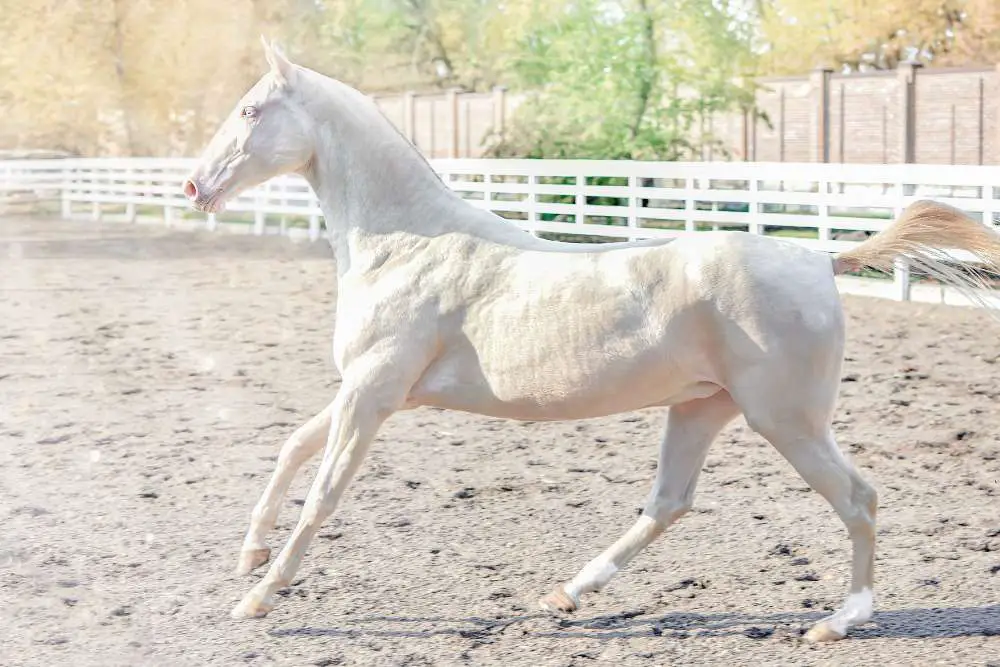
What Is The Rarest Horse Color?
The rarest horse color or coat pattern is either a chimera or a brindle, which is thought to be a type of chimera.
Are Blue Roan Horses Rare?
Roaning patterns are not particularly rare. However, blue roans are the rarest out of the three main roan colors known as red roan, bay roan, and blue roan. There can be other color combinations when more genes are involved, such as palomino roan and buckskin roan. They would be even more rare.
Are Palomino Paint Horses Rare?
Palomino paint horses are not considered rare, but they are more uncommon than standard palominos. Not only do they need a gene for the pinto pattern, but they also need the cream gene and the chestnut base coat color.
How Rare Are Palomino Horses?
Palomino horses are not a rare horse color. Many horse breeds can come in the palomino color. However, it is a more uncommon color than the base coat colors chestnut, black, and bay.
How Rare Are White Horses, Or Are They A Common Color?
True white horses are very rare. Grey horses that have faded to a pure white color are common and often mistaken for white horses. White horses are born white and have pink skin, while grey horses are born their base color and gradually whiten as they age, and they have blackish grey skin.
Conclusion
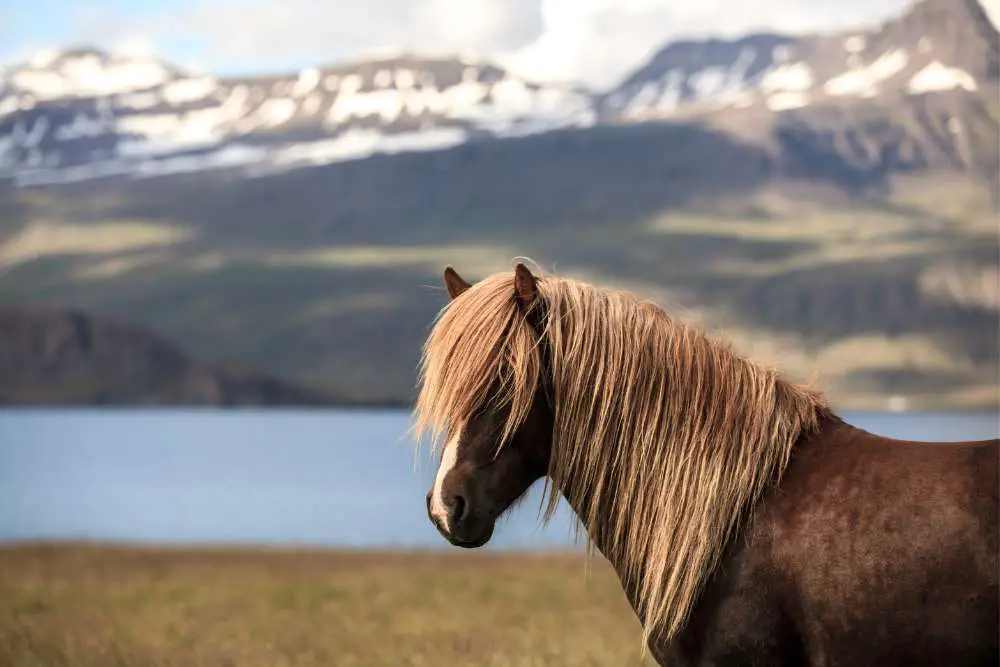
All horses are beautiful, but those with these bold and unusual coat colors really stand out. This list of the rarest horse colors does not include all the rare colors and patterns out there in the equine world. Horse and pony coat genetics are very complicated, and there are many genes that can coincide. For example, just about any color can be coupled with the gene for roaning.
So be on the lookout for other rare colors not included in this list and share them with us in the comments!
Cheers, Kacey
P.S. Did you like this article? Gallop over to:

